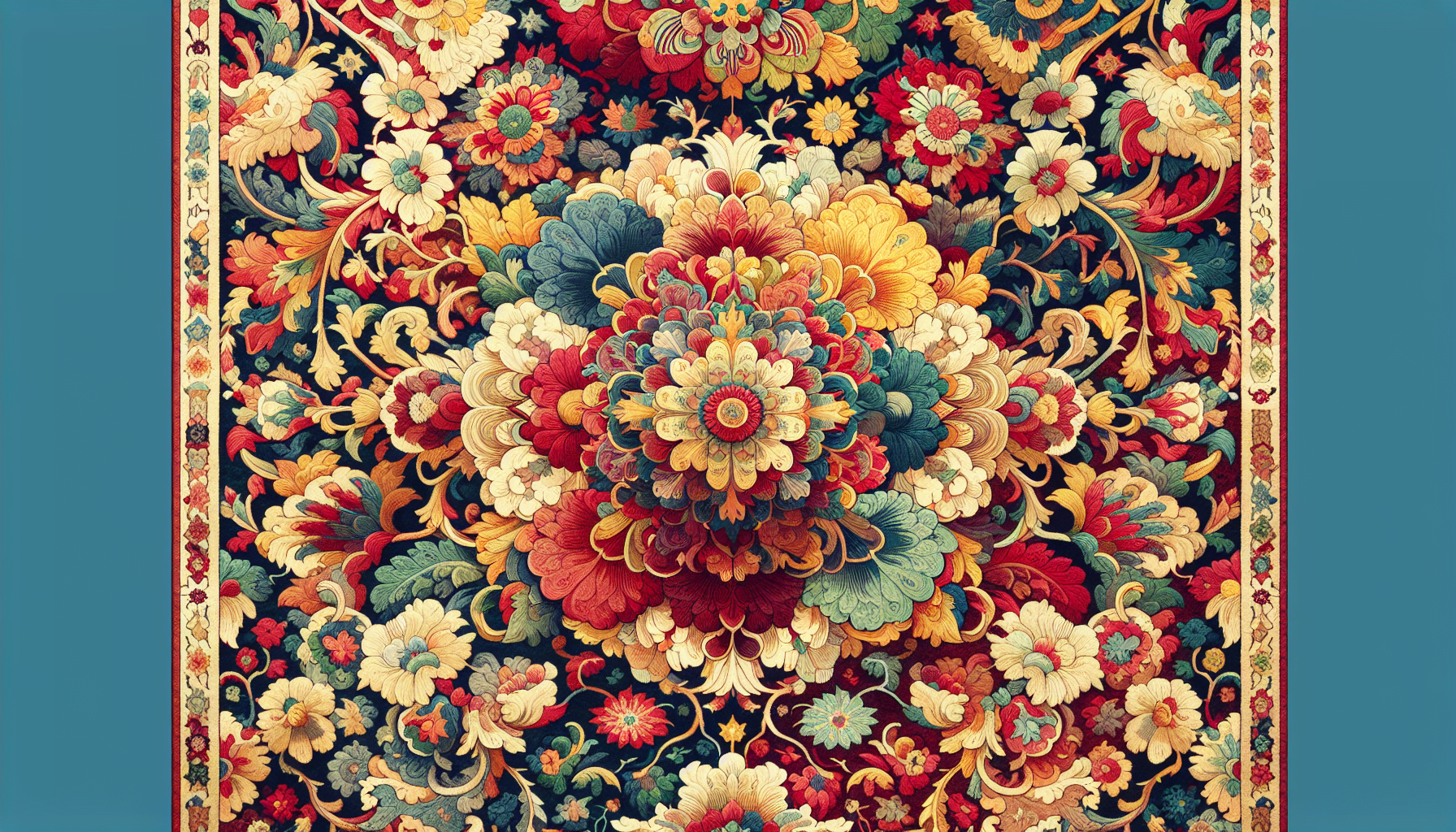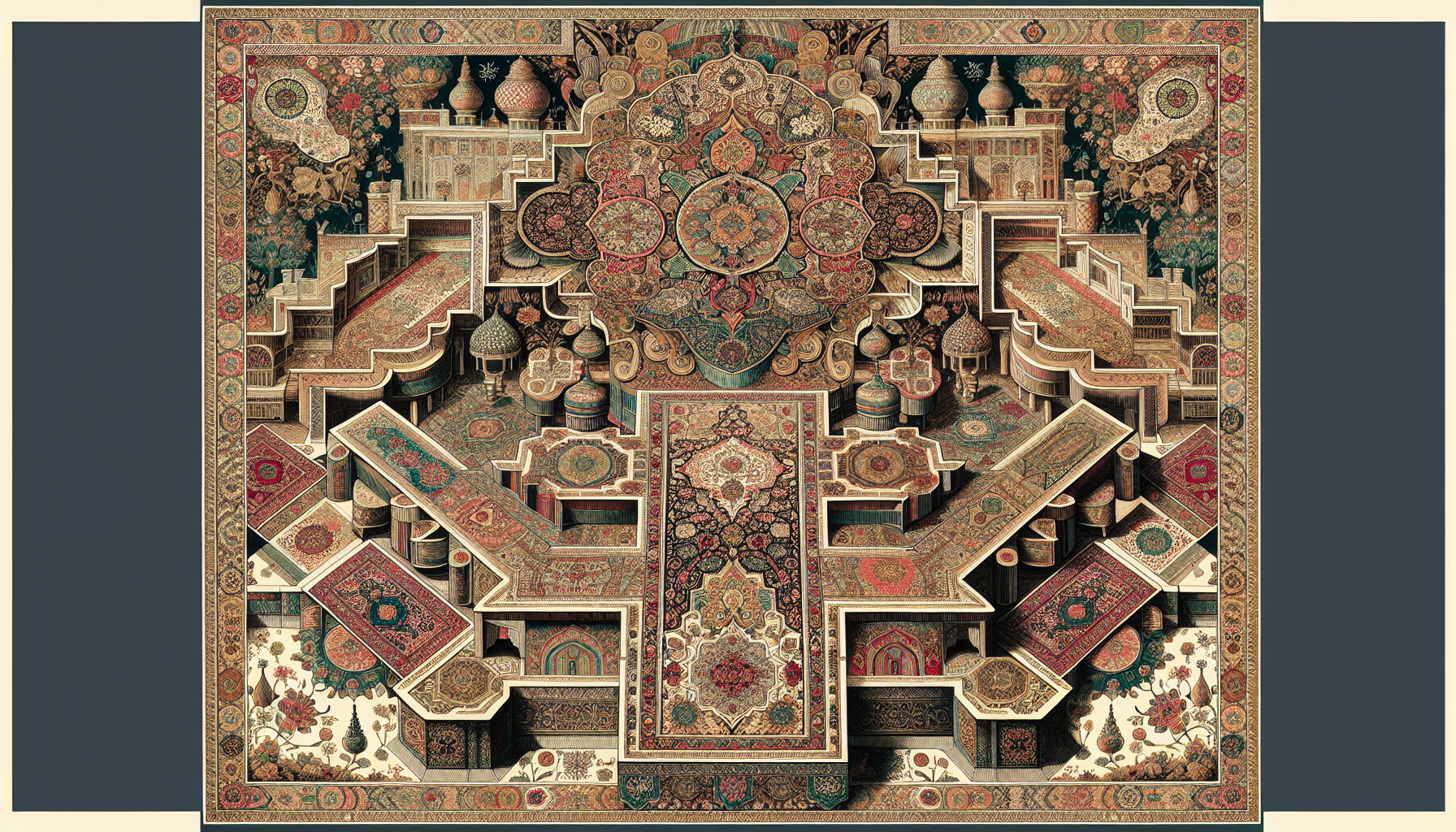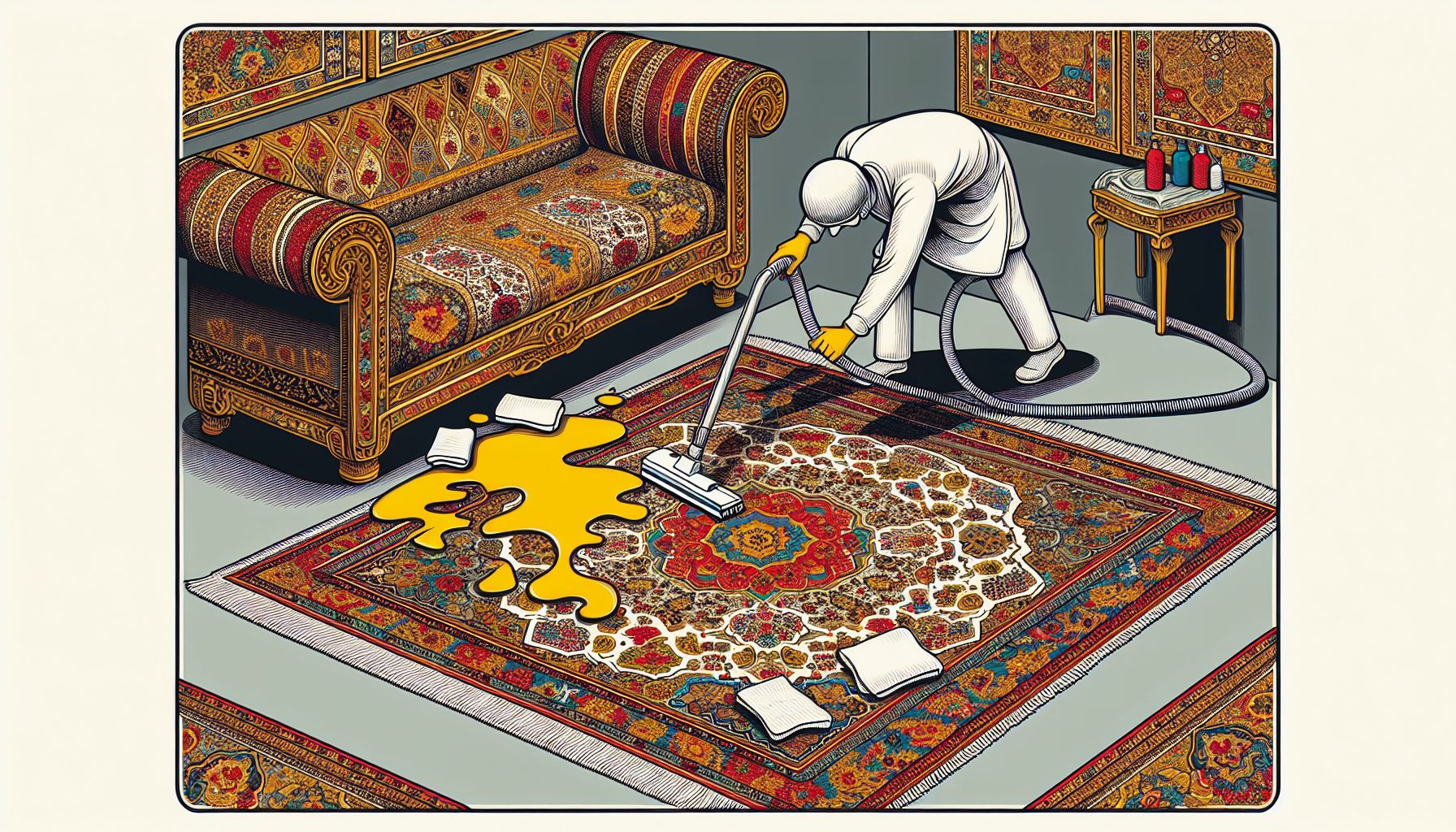Determining a Persian rug’s authenticity should not be a guessing game. This guide will equip you with the essential markers to look for, including material quality, knot density, and design origins. We provide focused insights to help you understand how to identify Persian rugs effectively, so you can make informed decisions without getting lost in the details.
Jump to section
Key Takeaways
Genuine Persian rugs are distinguished by their natural materials (such as sheep’s wool, silk, cotton), high knot density, unique imperfections, and crafting methods that reflect the rich heritage of Iranian artistry.
The specific regional styles, color palettes, and motifs of a Persian rug serve as identifiers of its origins in Iran, each telling the cultural and historical narratives of the region it was created.
The value of a Persian rug is influenced by its age, condition, rarity, and provenance, with antique rugs being at least 70 years old; proper care and professional restoration can enhance their value and longevity.
Distinguishing Genuine Persian Rugs

Persian rugs, creations of exceptional artistry, are more than just floor coverings. They are handcrafted masterpieces, each one reflecting the rich heritage of its Iranian origin. So, how can we distinguish a genuine Persian rug from others? The answer lies in its composition, knot density, and unique imperfections.
These authentic rugs are more than mere decorations; they are a testament to the craftsmanship of the weavers. Each rug is a unique story, woven through the hands of skilled artisans, carrying the essence of its origin in every thread. Learning to distinguish an authentic Persian rug involves understanding these unique characteristics and appreciating the artistry that goes into each piece.
Material Composition
Authentic Persian rugs are a testament to nature’s bounty. Traditionally made from natural materials like sheep’s wool, pure silk, and cotton, these rugs are a reflection of the landscapes from which they originate. When touched, they should feel smooth and slightly oily, a sign of high-quality natural materials. An authentic oriental rug, especially those of Persian origin, truly showcases the beauty and craftsmanship of these timeless pieces. A genuine oriental rug is a valuable addition to any home, offering both comfort and style. With genuine oriental rugs, you can experience the rich history and artistry of these exquisite creations.
Synthetic materials, on the other hand, are a clear indication of a rug that lacks authenticity. Genuine Persian rugs are crafted using the finest materials, often wool from high-altitude regions, enhancing their durability and value. Their composition, therefore, is a crucial factor in distinguishing a genuine Persian rug from a machine-made counterpart.
Knot Density and Quality
The knot density of a Persian rug is a reflection of its fineness and craftsmanship. A higher knot density results in more attractive and detailed designs, making it a direct indicator of the rug’s value. Hand-knotted oriental rugs, made of natural sheep’s wool, are more robust and durable than machine-made rugs, which are often made of synthetic fibers and tend to break over time.
The back of a rug can reveal a wealth of information about its creation. Some key features to look for on the back of the rug include:
Single knots, which indicate a handcrafted origin
A larger color variety, which is characteristic of handmade rugs, especially in the case of a handmade oriental rug
An intricate knot structure, which demonstrates the skill and effort put into its creation
These features set genuine Persian rugs apart from machine-made counterparts and contribute significantly to their value.
Craftsmanship and Imperfections
Hand-woven Persian rugs often exhibit slight imperfections and variations in their knot work. This is not a flaw, but rather a mark of authenticity, setting them apart from machine-made pieces. These slight irregularities are a testament to the human touch involved in the weaving process and add to the charm of hand knotted rugs.
An authentic Persian rug’s fringe is an integrated part of its weave, unlike inauthentic rugs where the fringe may be glued or sewn on post-production. When inspecting a rug, look closely at the design on both the front and back. Handmade rugs will demonstrate subtle imperfections from being woven on wooden looms, a testament to their authenticity and craftsmanship.
Recognizing Common Rug Origins

Persian rugs carry the essence of their birthplace, Iran, formerly known as the Persian Empire. The specific regional styles, color palettes, and motifs are unique identifiers of these rugs, each region in Iran contributing its unique take to the craft. The designs and construction of these rugs shed light on the weaver’s personal experiences, as well as the social and historical influences of the region, making each rug a unique piece of art.
The origin of a Persian rug can be read like an open book, providing insights into its creators’ lives and the historical context of its creation. It’s a testament to the rich cultural heritage of Iran, a tapestry of history woven in threads of wool and silk. An oriental rug, especially a Persian one, holds a unique charm and beauty that is truly timeless.
Regional Styles
Each region in Iran brings its unique style to the art of rug weaving. Tabriz rugs, known for their short pile and high knot-density, incorporate medallions and floral motifs into their designs, reflecting the region’s rich artistic heritage. Gabbeh rugs, crafted by Qashqai nomads, feature geometric patterns and often depict animals or landscapes, a reflection of their nomadic lifestyle.
Bakhtiari rugs, woven by a nomadic tribe, are characterized by their durability and designs, combining geometric shapes with floral garden motifs. The Herati pattern, a symbolic representation of small fishes in moon reflection, originates from Herat. Each of these regional styles carries unique features and deep symbolism, reflecting the diverse cultural tapestry of Iran.
Design Influences
Persian rugs are renowned for their intricate designs, steeped in cultural and historical significance. The symbolism woven into each rug is closely linked to its place of origin and can vary widely across different regions. By analyzing these designs, one can gain historical insights about specific places in Iran where these rugs were created.
The patterns and motifs in a Persian rug are not mere decorations but are narratives encoded in thread and color. They tell the story of the weaver’s life, the community they lived in, and the historical events that shaped their existence. Each rug is a piece of history, a testament to the weaver’s skill and the rich cultural heritage of its place of origin.
Evaluating Rug Age and Value
The age and value of a Persian rug are reflected in its:
Condition
Wear
Rarity
Provenance
Signs of wear such as fraying or fading and the condition of the fringe can indicate a rug’s age. To identify antique Persian rugs, it is essential to know that an antique Persian rug is typically required to be at least 70 years old for classification as an antique. This age requirement is crucial for establishing the historical significance and value of antique rugs.
The value of a Persian rug increases with its age, especially if the rug has withstood the test of time with grace and durability. Professional restoration plays a significant role in enhancing the value of a Persian rug by maintaining or improving its condition, ensuring that these timeless pieces of art continue to enchant generations.
Condition and Wear
Antique Persian rugs may exhibit wear such as fraying, fading, or a well-worn appearance, which can affect their price and often indicate their age. To maintain a rug’s appearance and value, uniform wear can be achieved through regular rotation, especially in areas with high foot traffic, and preventing direct sunlight exposure to avoid significant fading.
Additional protection measures, like placing padding under the rug to maintain its shape and reduce wrinkling, and rearranging furniture to avoid excessive wear, contribute to the rug’s overall value. Implementing care routines such as avoiding direct sunlight and frequent rotation of the rug helps in evenly distributing wear and preventing fade, crucial for the rug’s long-term preservation.
Rarity and Provenance
The provenance of a Persian rug, detailing its history and previous ownership, is critical in assessing both its rarity and its value. A well-documented provenance that traces a Persian rug’s history enhances its authenticity and can significantly increase its market value. Checking for a signature on a Persian rug can help determine its provenance, with known workshops or weavers like Seirafian increasing its rarity and value.
A Persian rug’s value is not just in its age or craftsmanship but also in its story. The rug’s history, its journey through time, and the hands it passed through all contribute to its uniqueness and value. It’s a piece of history that you can touch, and the story it tells is a priceless treasure.
Decoding Rug Patterns and Motifs

Persian rugs are like an open book, their design elements such as:
Borders
Fields
Medallions
Motifs
are key to their identification. Each element works together to create a harmonious whole, a testament to the skill of the weaver and the rich cultural heritage of the rug.
The designs on a Persian rug are not just for aesthetics but are symbols, each telling a different part of the rug’s story. From the intricate borders that frame the rug’s narrative to the motifs that dance across its field, each element is a chapter in the rug’s tale, waiting to be read and appreciated.
Symbolism in Rug Designs
Colors in Persian rugs often carry deep symbolism. Green represents hope and life, red signifies wealth and joy, and blue symbolizes the afterlife. Animal depictions, such as lions, symbolize power, birds signify good luck, while floral and plant motifs carry various meanings. The Boteh motif, which can resemble a teardrop or paisley, is frequently found in Persian rugs, representing a range of concepts from fertility and eternal life to the garden of paradise.
The symbolism in Persian rugs is passed down through generations, often depicting historical events, scenes from daily life, or religious imagery such as the Tree of Life. These symbols provide a deeper understanding of the rug’s story and the culture it comes from, making each rug a unique piece of art filled with hidden meanings.
Identifying Rug Styles
Identifying the style of a Persian rug can provide insights into its city or country of origin, as well as the historical context of the rug. These styles include:
Herati
Boteh
Vase
Göl
Each representing different significances.
The style of a Persian rug tells a story about the people who created it, the place it comes from, and the time it was made. It’s a glimpse into the past, a reflection of the weaver’s life, and the cultural and historical influences that shaped it. These styles are not just design elements but are a language in themselves, each one conveying a unique message.
Tips for Buying Authentic Persian Rugs

When looking to buy a genuine Persian rug, several factors come into play. It’s important to consider whether you prefer tribal rugs, known for their bold colors and looser weaves, or city rugs, which feature more elaborate patterns and higher knot counts. Engaging with a trusted dealer when purchasing a Persian rug is also crucial.
Purchasing a Persian rug is not just about buying a piece of decor but investing in a piece of history. It requires careful consideration and understanding, not just of the rug’s design and quality, but also of its origin, history, and the story it tells.
Trusted Sources
Buying from reputable dealers is crucial when purchasing Persian rugs. These sellers are committed to selling items that are reliably sourced and adhere to quality standards, ensuring that you are investing in a genuine piece of art. Rug Source, for instance, is an exemplary online retailer known for its authentic, hand-woven Persian rugs that complement a variety of home decorating styles.
Reputable dealers of Persian rugs:
are not just sellers, but are custodians of a rich cultural heritage
understand the value and importance of these rugs
treat each piece with the respect it deserves
ensure that it finds a home where it will be appreciated and cared for.
Inspecting Rugs Before Purchase
Before purchasing a Persian rug, it’s important to thoroughly inspect it. Here are some things to check:
Rug’s edges, ends, and fringe for neatness and material quality as an indicator of good craftsmanship
Back for a dense knot structure
Perform a color test using a damp rag to evaluate authenticity
Each Persian rug is a work of art, and like any piece of art, it should be carefully examined before purchase. Here are some factors to consider when evaluating a Persian rug:
The feel of the rug
The vibrancy of its colors
The tightness of its knots
The quality of its materials
These factors all contribute to the value and authenticity of the rug.
Caring for Your Persian Rug

A Persian rug is a valuable investment, and like any investment, it requires careful care and maintenance. Regular vacuuming using a non-beater bar vacuum cleaner can prevent dirt from settling into the fibers. Persian rugs should be rotated 180 degrees at least once a year to ensure even wear and to prevent patterns of sunlight exposure.
In the event of a liquid spill, the area should be blotted to remove moisture and then elevated to air dry; avoid rubbing the spill. Seeking professional restorers for repair needs, especially for tears, holes, or fringe damage, can preserve the rug’s value and integrity.
Cleaning and Maintenance
Cleaning and maintenance of Persian rugs include:
Vacuuming: Vacuum carefully using a low setting and without a beater bar to prevent damage to the delicate fibers.
Addressing spills promptly: Absorb the liquid promptly with a dry cloth and use only water for cleaning to avoid fiber damage.
Professional cleaning every three to five years.
Professional cleaning every three to five years is advised to eliminate dirt buildup and rejuvenate the rug’s natural fibers. Fringes can be straightened naturally by flipping the rug end over end and odors can be mitigated by airing out the rug semi-annually or after moisture exposure.
Repair and Restoration
Repair and restoration services for Persian rugs can enhance their value by maintaining their structural integrity and excellent condition. These services include reweaving damaged areas, securing loose edges, and replacing or repairing fringes. These repair services are crucial for maintaining the structural integrity of Persian rugs, ensuring that damage does not propagate and compromise the rug’s durability.
Professional restoration services can enhance the value of Persian rugs by keeping them in excellent condition, which is especially important for antique or collectible pieces. This ensures that these timeless pieces of art continue to enchant for generations to come, carrying with them the stories and history of a bygone era.
Summary
In this journey through the world of Persian rugs, we’ve discovered that each rug is a unique masterpiece, a testament to the skill and heritage of its weavers. With designs influenced by their region of origin, these rugs carry a rich history and cultural significance in every knot and color. When purchasing a Persian rug, we do not merely acquire a piece of decor, but a piece of history, a work of art that will continue to charm and inspire for generations to come.
Frequently Asked Questions
What materials are used in genuine Persian rugs?
Genuine Persian rugs are traditionally made from natural materials such as sheep’s wool, pure silk, and cotton, ensuring high quality and durability.
How can one distinguish an authentic Persian rug from a machine-made rug?
You can distinguish an authentic Persian rug from a machine-made one by looking for slight imperfections and variations in knot work, and by checking whether the fringe is integrated into the weave, rather than glued or sewn on afterward. This helps to ensure the rug’s hand-crafted origin.
What does the provenance of a Persian rug indicate?
The provenance of a Persian rug is important because it determines its rarity and value. It provides crucial information about the rug’s history and previous ownership.
What care and maintenance does a Persian rug require?
To keep your Persian rug in good condition, be sure to regularly vacuum it, clean up spills promptly, and have it professionally cleaned every three to five years. Regular maintenance will help preserve the quality and appearance of your rug.
How does the style of a Persian rug provide insights into its origin?
The unique styles and patterns of Persian rugs provide insights into the city or country of origin, as well as the historical context of the rug. This helps in identifying the origin of a Persian rug.